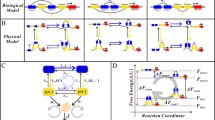Abstract
Quantitative models of gene regulatory activity have the potential to improve our mechanistic understanding of transcriptional regulation. However, the few models available today have been based on simplistic assumptions about the sequences being modeled or heuristic approximations of the underlying regulatory mechanisms. In this work, we have developed a thermodynamics-based model to predict gene expression driven by any DNA sequence. The proposed model relies on a continuous time, differential equation description of transcriptional dynamics. The sequence features of the promoter are exploited to derive the binding affinity which is derived based on statistical molecular thermodynamics. Experimental results show that the proposed model can effectively identify the activity levels of transcription factors and the regulatory parameters. Comparing with the previous models, the proposed model can reveal more biological sense.







Similar content being viewed by others
References
Wang JB (2012) Next Generation Microarray Bioinformatics (Chapter 16). Humana Press
Bansal M, Belcastro V, Ambesi A, Bernardo I (2007) How to infer gene networks from expression profiles. Mol. Syst Biol 3:78
Karlebach G, Shamir R (2008) Modelling and analysis of gene regulatory networks. Nat Rev Mol Cell Biol 9:770–780
Wang SQ, Li HX. Quantitative modeling of transcriptional regulatory networks by integrating multiple source of knowledge. Bioprocess Biosyst Eng 35:1555–1565
Davidich M, Bornholdt S (2008) Boolean network model predicts cell cycle sequence of fission yeast. PLoS ONE 3:e1672
Lahdesmaki H, Shmulevich I, Yli-Harja O (2004) On learning gene regulatory networks under the Boolean network model. Mach Learn 52:147–167
Imoto S, Goto T, Miyano S (2002) Estimation of genetic networks and functional structures between genes by using Bayesian networks and nonparametric regression. Proc Pac Symp Biocomput 7:175–186
Kirimasthong K, Manorat A (2007) Inference of gene regulatory network by Bayesian network using Metropolis-Hastings Algorithm. ICDM, pp. 276–286
Segal E, Taskar B, Gasch A, Friedman N, Koller D (2001) Rich, probabilistic models for gene expression. Bioinformatics 17:243–252
Hu Z, Killion P, Iyer V (2007) Genetic reconstruction of a functional transcriptional regulatory network. Nat Genet 39:683–687
Luscombe N, Babu M, Yu H (2004) Genomic analysis of regulatory network dynamics reveals large topological changes. Science 431:308–312
Adriano V, Dirk H (2007) Reconstructing gene regulatory networks with Bayesian networks by combining expression data with multiple sources of prior knowledge. Stat Appl Genet Mol Biol. 6:A15
Segal E, Barash Y, Simon I, Friedman N (2002) From promoter sequence to expression: a probabilistic framework. RECOMB, pp. 263–272
Guido S, Magnus R, Neil LD (2006) A probabilistic dynamical model for quantitative inference of the regulatory mechanisms of transcription. Bioinformatics 22:1753–1759
Holter N, Mitra M, Maritan A (2000) Fundamental patterns underlying gene expression profiles: simplicity from complexity. Proc Natl Acad Sci USA 97:8409–8414
Liebermeister W (2002) Linear modes of gene expression determined by independent component analysis. Bioinformatics, vo. 18:51–60
Pournara I, Wernisch L (2007) Factor analysis for gene regulatory networks and transcription factor activity profiles. BMC Bioinformatics 8:61
Nachman I, Regev A, Friedman N (2004) Inferring quantitative models of regulatory networks from expression data. Bioinformatics 20:248–256
Imoto S, Kim S, Goto T (2003) Bayesian network and nonparametric heteroscedastic regression for nonlinear modeling of genetic network. J Bioinform Comput Biol 1:231–252
Segal E, Raveh-Sadka T et al (2008) Predicting expression patterns from regulatory sequence in Drosophila segmentation. Nature 451:535–540
Tanay A (2006) Extensive low-affinity transcriptional interactions in the yeast genome. Genome Res 16:962–972
Kaplan N et al (2008) The DNA-encoded nucleosome organization of a eukaryotic genome. Nature 458:362–366
Benos P, Martha L, Bulyk M, Stormo G (2002) Additivity in protein–DNA interactions, how good an approximation is it? Nucleic Acids Res 30:4442–4451
Naum I, Gary D, Ilya P (2005) Computational technique for improvement of the position-weight matrices for the DNA/protein binding sites. Nucleic Acids Res 33(7):2290–2301
Guido S, Andreas R, Manfred O, Cedric A (2009) Switching regulatory models of cellular stress response. Bioinformatics 25:1280–1286
Cover T, Thomas J (2006) Elements of information theory. Wiley, New York
Panda S, Antoch MP, Miller BH et al (2002) Coordinated transcription of key pathways in the mouse by the circadian clock. Cell 109:307–320
Yan J, Wang HF, Liu YT, Shao CX (2008) Analysis of Gene Regulatory Networks in the Mammalian Circadian Rhythm. PLoS Comput Biol 4(10):e1000193
Barenco M, Tomescu D et al (2006) Ranked prediction of p53 targets using hidden variable dynamic modeling. Genome Biol 7(3):R25
Acknowledgments
The authors would like to thank the editor and the anonymous reviewers for their constructive comments that helped to improve the paper. This work was supported in part by China Postdoctoral Science Foundations (Grants No. 2014M562223 and No. 2015T80925), Shenzhen Basic Research Project (Grant No. JCYJ20140610151856729) and National Natural Science Foundations of China (Grants No. 61503368 and No. 61502473) and Natural Science Foundation of Guangdong Province (Grant No. 2014A030310154).
Author information
Authors and Affiliations
Corresponding author
Rights and permissions
About this article
Cite this article
Wang, S., Shen, Y. & Hu, J. Thermodynamics-based models of transcriptional regulation with gene sequence. Bioprocess Biosyst Eng 38, 2469–2476 (2015). https://doi.org/10.1007/s00449-015-1484-6
Received:
Accepted:
Published:
Issue Date:
DOI: https://doi.org/10.1007/s00449-015-1484-6




